Arizona_10m_Lineaments
Arizona lineaments derived from 10m DEM multi-directional hillshade
Authors:
- name:
given: Ryan E.
family: Lima
degrees:
- PhD
orcid: 0000-0002-5352-7215
corresponding: true
email: ryan.lima@nau.edu
roles:
- Investigation
- Software
- Visualization affiliations:
- Northern Arizona University
- School of Informatics, Computing & Cyber Systems
- School of Earth and Sustainability
- name: Calvin A. Mako
affiliations:
- Arizona Geological Survey
- University of Arizona
- name: Abraham E. Springer
degrees:
- PhD
corresponding: false
roles: []
affiliations:
- Northern Arizona University
- School of Earth and Sustainability
- name: Temuulen Tsagaan Sankey
degrees:
- PhD
corresponding: false
roles: []
affiliations:
- Northern Arizona University
-
School of Informatics, Computing & Cyber Systems
Keywords:
- Arizona
- lineaments
- karst
- remote sensing
- GIS
- groundwater recharge
Abstract:
Lineaments are linear or curvilinear features on the Earth’s surface that often correspond to underlying geologic structures such as faults, fractures, folds, or joints in the rock which may be pathways for enhances groundwater recharge. This dataset contains lineaments extracted from a 10m digital elevation model (DEM) of Arizona. The DEM was processed to create a multi-directional hillshade. The hillshade was then imported into Catalyst’s Focus module and lineaments were extracted using the LINE algorithm. Several parameter values were tested to optimize the extraction of lineaments, parameters were chosen by qualitative visual analysis. The resulting lineaments were filtered to remove lineaments along major roadways, railroads, and other anthropogenic features. The resulting Arizona 10m lineaments layer was then evaluated against hand drawn lineament maps from three areas within Arizona, accuracies are reported in the dataset. Lineament density was than calculated for each 30x30m cell using a radius of 1,500m. The Lineament density layer was then reclassified into classes 5-10 using a geometric progression. This dataset is intended to be used in MCDA (Multi-Criteria Decision Analysis) workflows to identify areas of enhanced groundwater recharge potential in Arizona.
key-points:
- Lineaments were extracted from a 10m DEM of Arizona using the LINE algorithm in Catalyst’s Focus module.
- Lineament accuracy was evaluated against hand drawn lineament maps from three areas within Arizona.
- Lineament density was calculated for each 30x30m cell using a radius of 1,500m.
Introduction
While aquifer properties such as primary permeability and porosity of the rock matrix are important for estimating potential recharge, secondary permeability and porosity, that is the fractures, faults, and voids within a given rock unit are often significant in estimate groundwater recharge potential. Within mountain blocks faults are believed to act as both conduits and barriers to groundwater flow. Due to intense fracturing, the saturated permeability along lineaments can be several orders of magnitude higher than undamaged rocks Wilson and Guan, 2004. In some crystalline bedrock, groundwater flow occurs exclusively within faults and fractures Meijerink et al., 2007;Nyborg et al., 2007.
Lineaments are curvilinear, or linear features on the earths surface and are treated as indicators of subsurface geologic structures such as fractures, faults, and joints O’leary et al., 1976. Linament analysis has been used for mapping geologically hazardous zones, mineral exploration, petroleum exploration, groundwater studies, and natural hazard assessments Zhumabek et al., 2017;Yeomans et al., 2019 Moore and Camm, 1982;Ni et al., 2016, Kresic, 1995; Mallast et al., 2011;Rutzinger et al., 2007. Lineaments and particularly lineament density is one of the most commonly used thematic layers in GIS-Multi-criteria Decision Analysis (GIS-MCDA) studies identifying potential recharge zones or managed aquifer recharge (MAR) suitability Wang et al., 2025;Fathi et al., 2020;Al-Adamat, 2012;Chenini et al., 2010;Chowdhury et al., 2010.
Geologic mapping in Arizona is limited to 500:000 scale state-wide and many areas within the state lack mapped lineament data. This research applies the most commonly used algorithm Catalyst LINE to identify lineaments across the entire state of Arizona based on a Multi-Directional Hillshade (MDHS) derived from a 10m DEM. This dataset can serve as a baseline for future lineament analyses across Arizona. This dataset will enable the first state-wide GIS-MCDA studies for groundwater recharge suitability.
Study Areas
The State of Arizona covers about 295,000 square kilometers, roughly the size of Italy. The state has over 3,800 meters of vertical relief and spans 10 different Koppen Climate Zones. Due to the size of the study area we chose three smaller study areas to assess the accuracy of our lineament data. The Thorn Peak study area was chosen because it is the subject of ongoing geologic mapping by the Arizona Geologic Survey and lineament data was readily available. The Woods Canyon area was chosen because it is along the Mogollon Rim, one of the most important areas for karst recharge within the State of Arizona. The N36W113 study area was chosen because of its large, well-defined lineaments apparent from satellite imagery and because it covers portions of all three of Arizona’s physiographic regions: the Colorado Plateau, Mogollon highland-Transition zone, and the Basin and Range. The Study areas area shown in figure y.
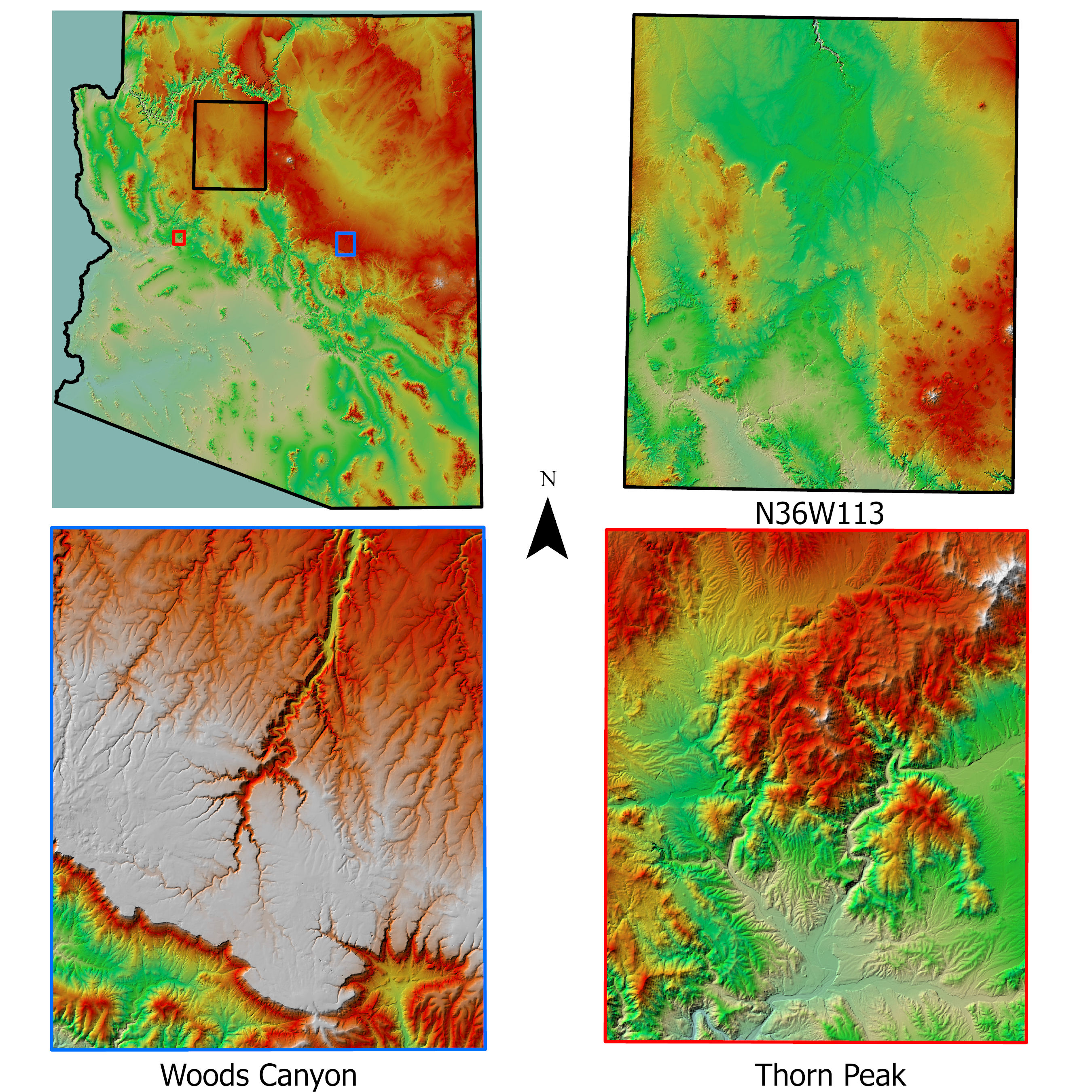
Data & Methods
DEM Processing
- A mosaic was created using the 1/3 arcsecond DEM tiles from the National Map
- the Spatial Analyst/
filtertool was used with a Low pass filter type to smooth noise from the DEM - raster functions/
hillshadewas completed using multi-directional type and z = 5 (5x vertical exaggeration) resulting in a MDHS raster - The smoothed DEM MDHS was broken up into 9 tiles for processing using the
split rastertool
PCI Geomatica
LINE Parameters
- The tiles were opened in Catalyst (PCI Geomatica) focus module using the python scripting tool and the attached
Batch_PCI_Line.pyscript was run using the parameters listed below. Multiple parameter sets were evaluated qualitatively before selecting the parameters that appeared to best match mapped faults in the state.
| PARAM | Value | Parameter Description |
|---|---|---|
| radi | [10] | Filter Radius |
| gthr | [100] | Edge Gradient Threshold |
| lthr | [45] | Curve Length Threshold |
| fthr | [3] | Line Fitting Threshold |
| athr | [15] | Angular Difference Threshold |
| dthr | [35] | Linking Distance Threshold |
- Lineaments were exported as shapefiles for all 9 tiles
Shapefile Post-Processing
- the 9 lineament shapefiles were loaded in ArcGIS pro, and combined with the
mergetool. - A 500m Buffer around the Arizona Boundary shapefile was used to erase artifact lineaments at the edge of the DEM using the
erasetool - a 200m buffer was created around the 1M -Highways shapefile from the National Map, and a 50m buffer was created along the 1M- Rail line feature class from the national map, each was used to erase lineaments along roads and railroads with the
erasetool. - Manual cleaning was then conducted, where mining areas, major roads, railroads, and large urban areas were spot checked and artificial or human-made lineaments were removed.
Results
The LINE algorithm identified 220,697 features or lineaments within the state of Arizona. After erasing lineaments which represented edge artifacts along the boarder of the hillshade, and erasing features within Road or Railroad buffers or near large earth works such as mines we were left with approximately 217,288 lineaments see figure x. Lineament density, reported in km of lineaments (length) per square kilometer within a radius of 1,500m of each 30x30 pixel.
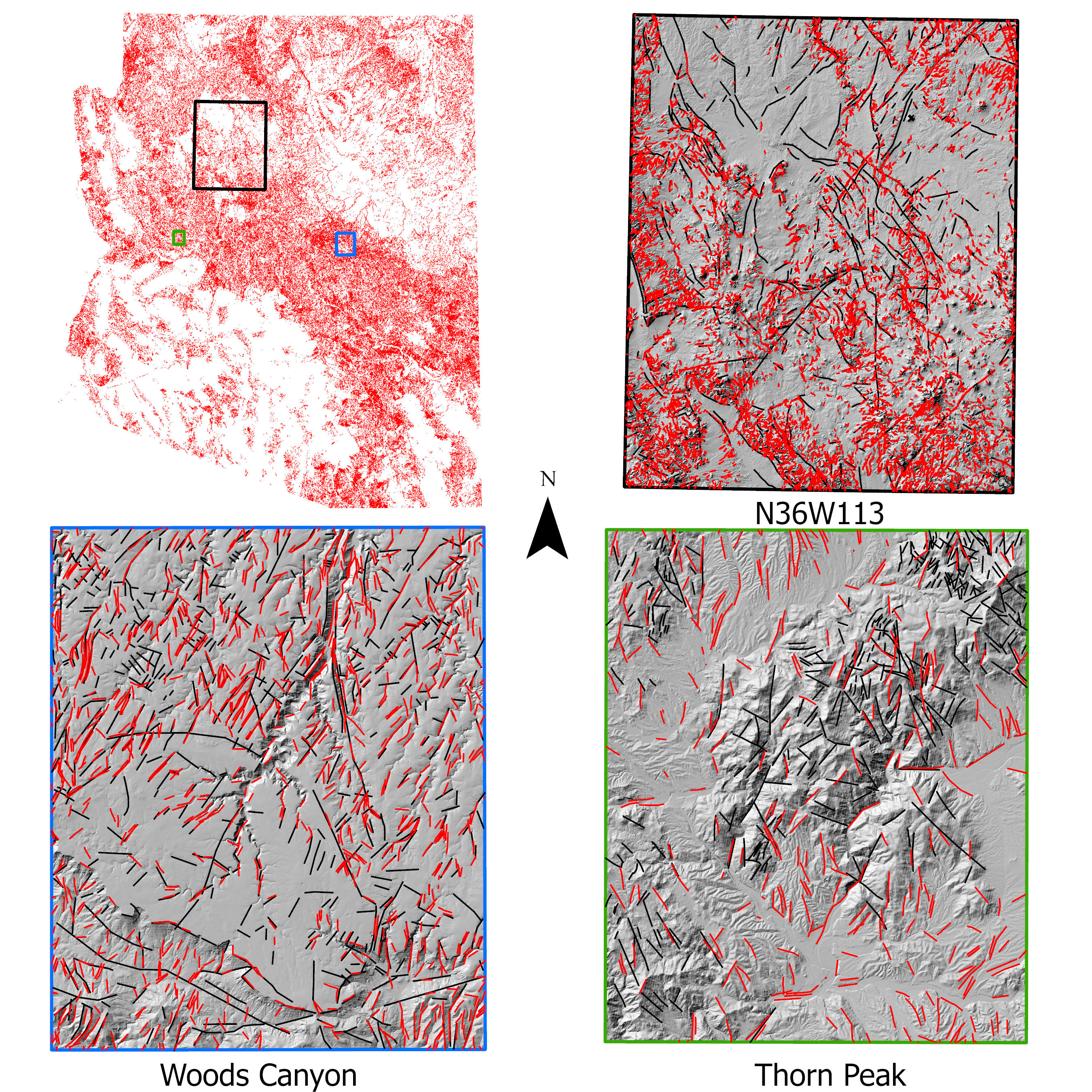
Lineament density across the state of Arizona varies from $0\frac{km}{km^2}$ to $6.182\frac{km}{km^2}$ the lineament density raster was then reclassified into 6 bins from 5 through 10 using a geometric transformation. The resulting layer can be combined as a thematic layer in MCDA studies where suitability is ranked between 1 and 10. We classified lineament density from 5-10 instead of 1-10 because absence of evidence for lineaments is not the same as evidence of absence, therefore areas with low or no lineament density are considered neutral or are give a 5 on a 1 - 10 scale. This choice is consistent with the use of lineament density in other suitability analyses Shaban et al., 2006.
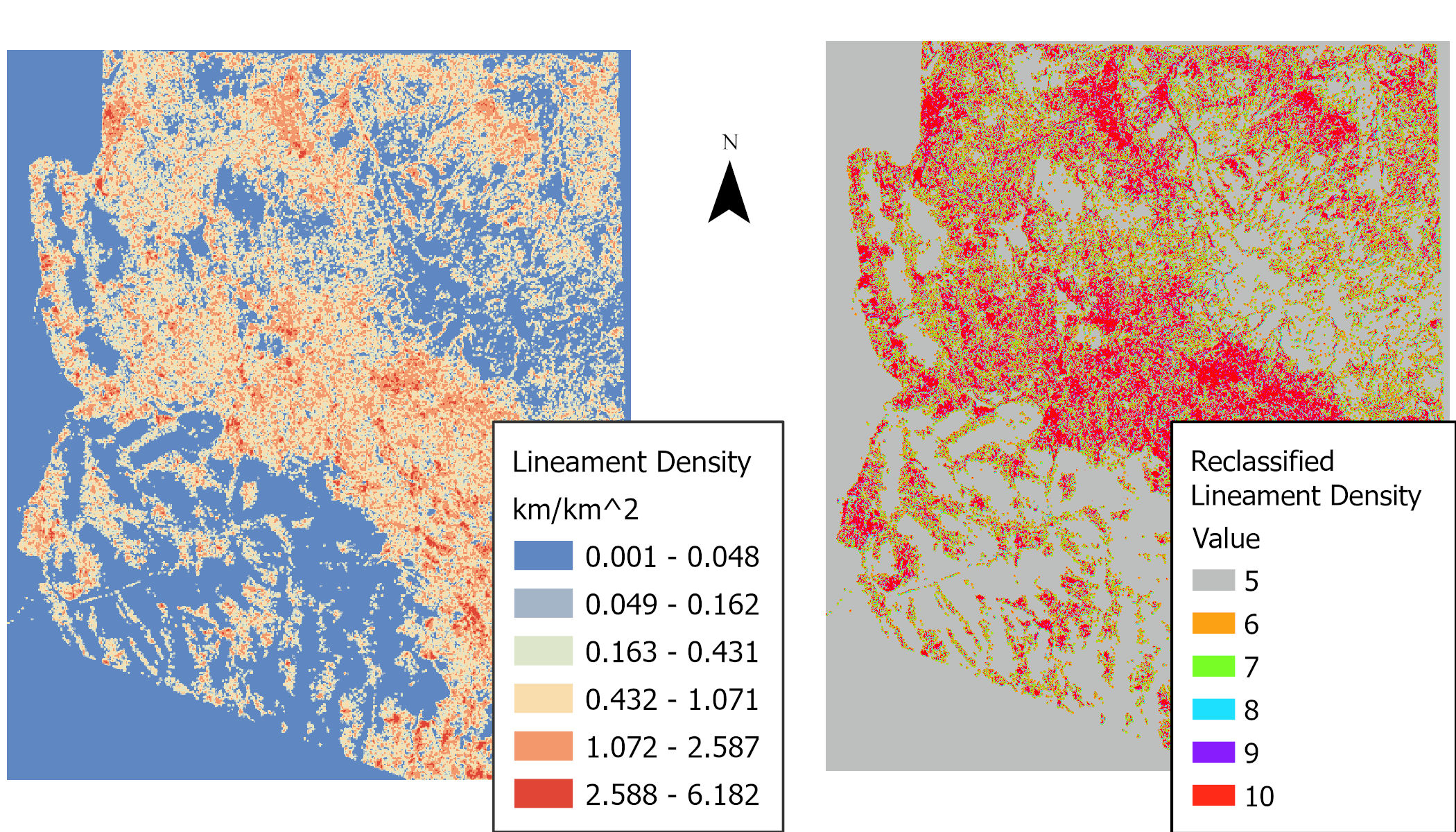
Accuracy Assessment
Rose Diagram Analysis
We compare the rose diagrams for each study area for both the reference lineaments and the predicted lineaments. Overall, the predicted lineaments show a similar distribution to the reference lineaments, particularly in the Woods Canyon and N36W113 study areas, less so in Thorn Peak. However the predicted lineaments often differ in frequency particularly in the largest study area N36W113, where many more lineaments were predicted then were present in the reference data.
Thorn Peak Lineament Rose Diagram
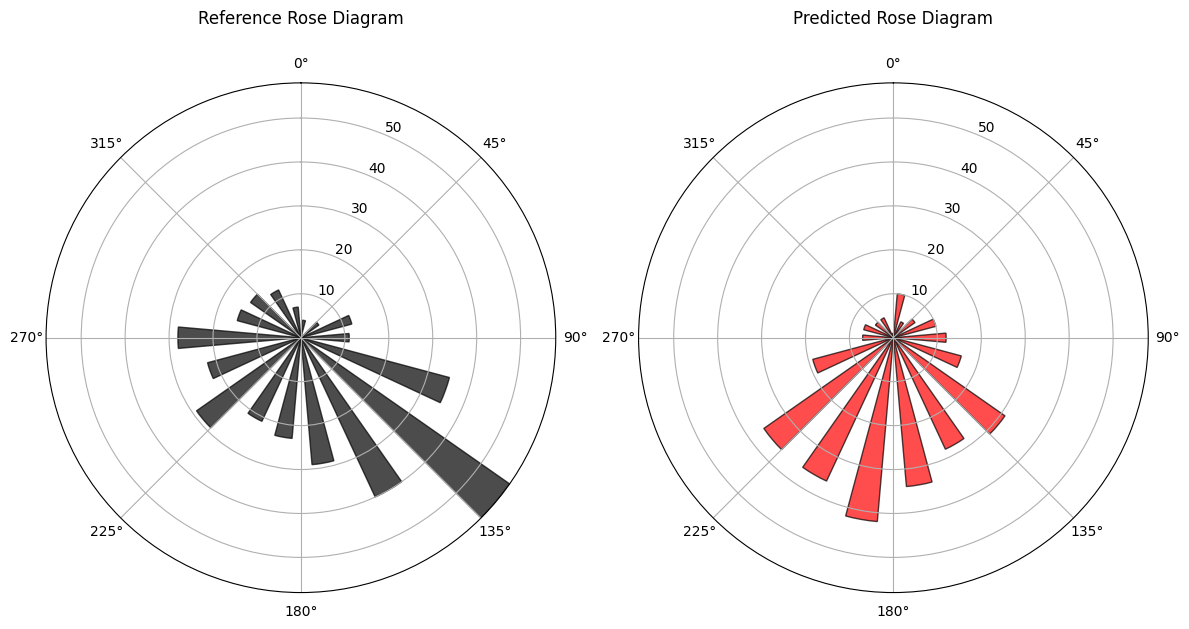
Woods Canyon Lineament Rose Diagram
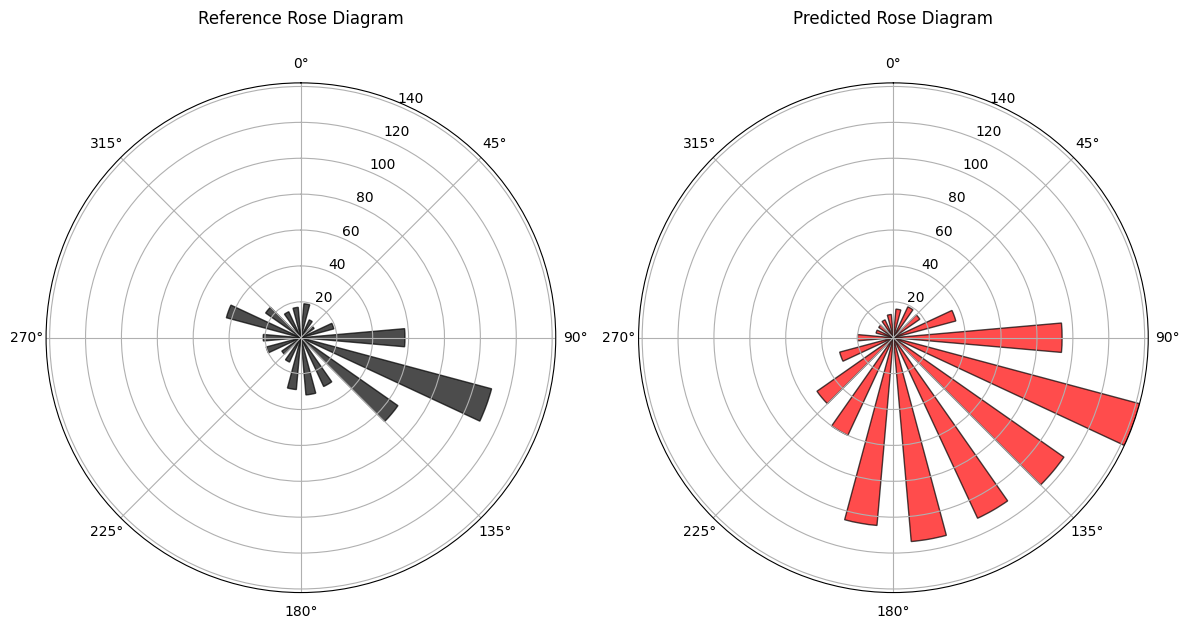
N36W113 Lineament Rose Diagram

Buffer Intersection Analysis
For each set of Reference Lineaments, a buffer was created around the lines to create a polygon. Then the predicted lineaments were compared to the reference lineaments using the Intersect tool resulting in the following table of accuracy metrics:
| Metric relative to REF | Thorn Peak | Woods Canyon | N36W113 |
|---|---|---|---|
| True Positive | 0.274 | 0.585 | 0.557 |
| False Positive | 0.714 | 0.482 | 0.711 |
| False Negative | 0.647 | 0.252 | 0.166 |
| Precision | 0.286 | 0.518 | 0.289 |
| Recall | 0.298 | 0.699 | 0.777 |
| F1 | 0.292 | 0.595 | 0.422 |
Hausdorff Distance Analysis
Hausdorff distance is an algorithm that calculated the maximum distance between two sets of points in metric space Hausdorff 1914. Freire and others 2002 used Hausdorff distance to compare mapped contour lines to remotely sensed contours, and Karimi and Karimi 2017 suggested Hausdorff distance as a metric for measuring the similarity sets of lineaments. The equation for calculating Hausdorff distance is shown below:
\[d_H(A, B) = \max \left( \sup_{a \in A} \inf_{b \in B} \|a - b\|,\; \sup_{b \in B} \inf_{a \in A} \|b - a\| \right)\]Where:
-
$(A, B)$ are two sets of points
-
$|a - b|$ is the distance (Euclidean) between points where $a$ is an element of set $A$ and $b$ is an element of set $B$; $a \in A \quad \text{and} \quad b \in B$
-
The expression finds the maximum distance of closest approach between the two sets.
For our analysis we compared $d_H (REF,PRED)$ for each study area with the results shown in table x
| metric | Thorn Peak | Woods Canyon | N36W113 |
|---|---|---|---|
| PRED LINES n | 306 | 967 | 6719 |
| REF LINES n | 365 | 552 | 622 |
| Mean REF->PRED | 500.71 m | 547.99 m | 1962.27 m |
| Median REF->PRED | 453.75 m | 445.87 m | 1444.95 m |
| Max REF->PRED | 1558.02 m | 6899.74 m | 20175.15 m |
| Mean PRED->REF | 1201.83 m | 503.72 m | 1560.40 m |
| Median PRED->REF | 824.76 m | 479.14 m | 1243.74 m |
| Max PRED->REF | 5051.90 m | 1450.23 m | 9164.82 m |
The results show that in the Thorn Peak and Woods Canyon areas where there was less class imbalance between the number of Predicted and Reference lines, moderate spatial agreement between predicted and reference lineaments. The N36W113 area however had relatively poor spatial agreement and a very high false positive rate. This may be due to the manual analysis taking place over a much larger area where much larger features were highlighted at the expense of smaller features. Furthermore, in the N36W113 area major faults from the Statewide 1:500,000 scale map were added, some without any surface expression, and without surface expression they would be difficult to segment using topographic data alone.
Manual Assessment of Extracted Lineaments
Finally, we assessed the lineaments manually in the Thorn Peak Quad, and then in an area not previously assessed. Manual assessment involved looking at the DEM and the extracted lineaments and labeling lineaments as Correct, Partially Correct, or Incorrect. Correct was used for predicted lineaments that appeared to accurately show a linear feature such as a fault or fracture. Partially Correct were predicted lineaments that captured part or partly captured a fault or fracture visible from the DEM. Predicted lineaments were deemed “incorrect” if they did not align with either an obvious fault or fracture. Often times these “incorrect lineaments” lined up with high-points or ridgelines, which may be related to faulting, but could just as easily be the result of erosional surface processes.
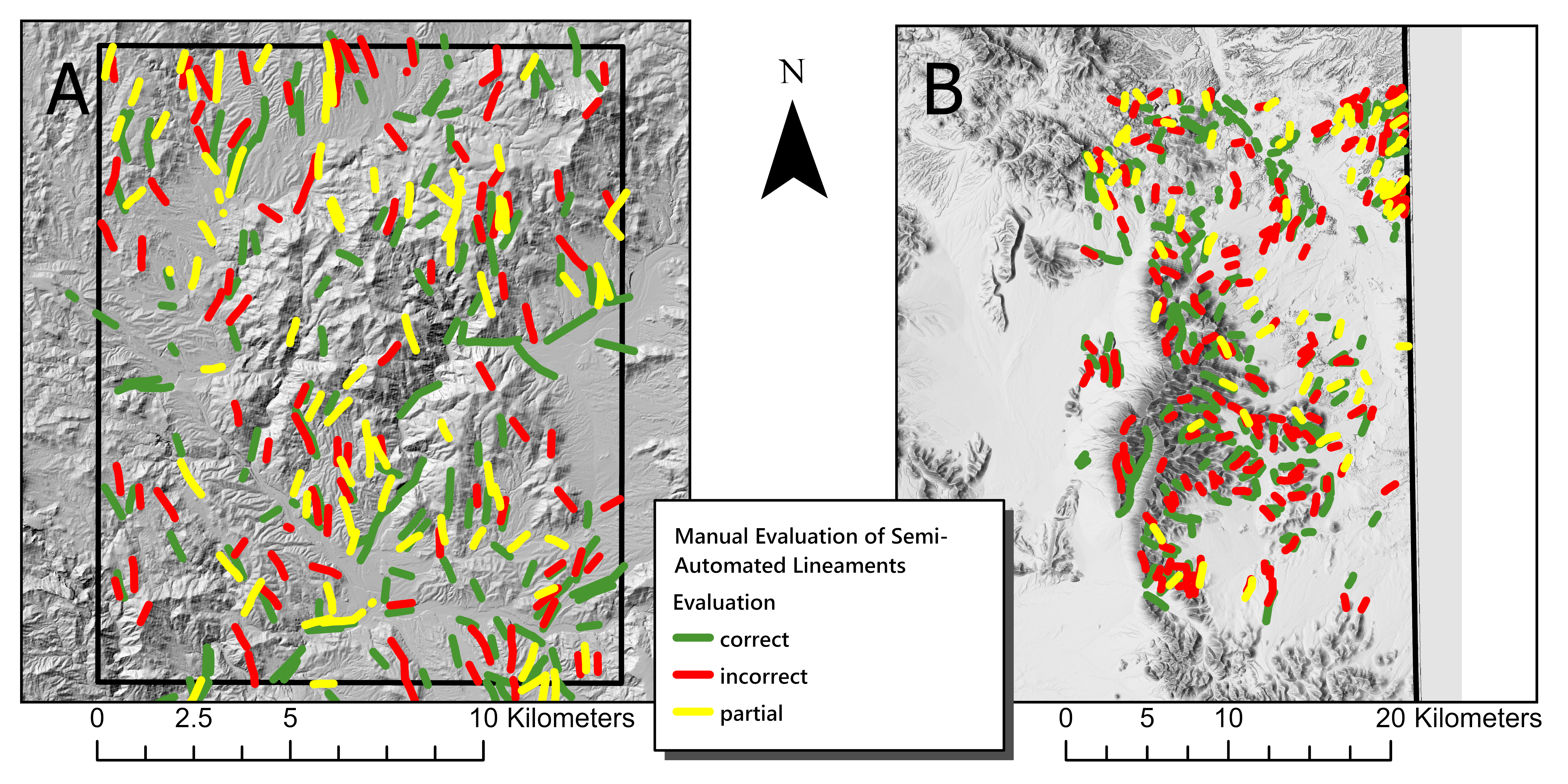
Figure x. Shows the Thorn Peak Quad area (A) on the left, and another previously un-evaluated area in SE Arizona (B). Predicted lineaments were compared to the Multi-Directional Hillshade as labeled as correct (Green), incorrect (Red), or partially correct (Yellow).
Manual Accuracy Values
| Category | Count | Percent of Total (n = 759) |
|---|---|---|
| Correct | 363 | 47.8% |
| Partially Correct | 138 | 18.2% |
| Incorrect | 258 | 34.0% |
#### “Weighted Accuracy” metric
We elected to use a weighted accuracy measure, where we weighted partially correct lineaments with a weight of 0.5, acknowledging that partially correct lineaments are still an important part of this methods performance while not inflating accuracy.
\[\text{Weighted Accuracy} = \frac{N_{\text{correct}} + 0.5 \times N_{\text{partial}}}{N_{\text{total}}}\]| Accuracy Type | Accuracy % |
|---|---|
| fully correct accuracy | 47.8% |
| Including partial matches | 66.0% |
| Weighted Accuracy | 56.917% |
## References
-
Al-Adamat, R. (2012). The Use of GIS and Google Earth for Preliminary Site Selection of Groundwater Recharge in the Azraq Oasis Area—Jordan. Journal of Water Resource and Protection, 04(06), 395–399. https://doi.org/10.4236/jwarp.2012.46045
-
Chenini, I., Mammou, A. B., & El May, M. (2010). Groundwater Recharge Zone Mapping Using GIS-Based Multi-criteria Analysis: A Case Study in Central Tunisia (Maknassy Basin). Water Resources Management, 24(5), 921–939. https://doi.org/10.1007/s11269-009-9479-1
-
Chowdhury, A., Jha, M. K., & Chowdary, V. M. (2010). Delineation of groundwater recharge zones and identification of artificial recharge sites in West Medinipur district, West Bengal, using RS, GIS and MCDM techniques. Environmental Earth Sciences, 59(6), 1209–1222. https://doi.org/10.1007/s12665-009-0110-9
-
Fathi, S., Hagen, J. S., & Haidari, A. H. (2020). Synthesizing existing frameworks to identify the potential for Managed Aquifer Recharge in a karstic and semi-arid region using GIS Multi Criteria Decision Analysis. Groundwater for Sustainable Development, 11, 100390. https://doi.org/10.1016/j.gsd.2020.100390
-
Freire, A. A. R., Antunes, M. A. H., De Barros, M. M., De Souza, W. D., De Sousa Da Silva, W., & De Souza, T. M. (2022). Similarity Analysis between Contour Lines by Remotely Piloted Aircraft and Topography Using Hausdorff Distance: Application on Contour Planting. Remote Sensing, 14(14), 3269. https://doi.org/10.3390/rs14143269
-
Hausdorff, F. (1914). Grundzuge der mengenlehre (Vol. 61). American Mathematical Soc.
-
Karimi, B., & Karimi, H. A. (2017). An Automated Method for the Detection of Topographic Patterns at Tectonic Boundaries. Patterns 2017. The Ninth International Conferences on Pervasive Patterns and Applications.
-
Kresic, N. (1995). Remote Sensing of Tectonic Fabric Controlling Groundwater Flow in Dinaric Karst. Remote Sensing of Environment, 53. https://doi.org/10.1016/0034-4257(95)00042-Y
-
Mallast, U., Gloaguen, R., Geyer, S., Rödiger, T., & Siebert, C. (2011). Semi-automatic extraction of lineaments from remote sensing data and the derivation of groundwater flow-paths [Preprint]. Groundwater hydrology/Remote Sensing and GIS. https://doi.org/10.5194/hessd-8-1399-2011
-
Meijerink, A. M., Bannert, D., Batelaan, O., Lubczynski, M., & Pointet, T. (2007). Remote sensing applications to groundwater (Vol. 16). Unesco Paris.
-
Moore, J., & Camm, S. (1983). Interactive enhancement of Landsat imagery for structural mapping in tin-tungsten prospecting- A case history of the S. W. England Orefield(U. K.). 727–740.
-
Ni, C., Zhang, S., Liu, C., Yan, Y., & Li, Y. (2016). Lineament Length and Density Analyses Based on the Segment Tracing Algorithm: A Case Study of the Gaosong Field in Gejiu Tin Mine, China. Mathematical Problems in Engineering, 2016, 1–7. https://doi.org/10.1155/2016/5392453
-
Nyborg, M., Berglund, J., & Triumf, C.-A. (2007). Detection of lineaments using airborne laser scanning technology: Laxemar-Simpevarp, Sweden. Hydrogeology Journal, 15(1), 29–32. https://doi.org/10.1007/s10040-006-0134-0
-
O’leary, D. W., Friedman, J. D., & Pohn, H. A. (1976). Lineament, linear, lineation: Some proposed new standards for old terms. Geological Society of America Bulletin, 87(10), 1463–1469. https://doi.org/10.1130/0016-7606(1976)87
-
Rutzinger, M., Maukisch, M., Petrini-Monteferri, F., & Stötter, J. (2007). Development of algorithms for the extraction of linear patterns (lineaments) from airborne laser scanning data. Proceedings of the Conference ’Geomorphology for the Future’ Obergurgl, 1–8. Scopus.
-
Shaban, A., Khawlie, M., & Abdallah, C. (2006). Use of remote sensing and GIS to determine recharge potential zones: The case of Occidental Lebanon. Hydrogeology Journal, 14(4), 433–443. https://doi.org/10.1007/s10040-005-0437-6
-
Wang, Y., Han, Y., Guo, Y., Wang, J., Wang, N., & Abdelkareem, M. (2025). The use of radar-optical remote sensing data and geographic information system–analytical hierarchy process–multicriteria decision analysis techniques for revealing groundwater recharge prospective zones in arid-semi arid lands. Open Geosciences, 17(1), 20220666. https://doi.org/10.1515/geo-2022-0666
-
Wilson, J. L., & Guan, H. (2004). Mountain-block hydrology and mountain-front recharge. In J. F. Hogan, F. M. Phillips, & B. R. Scanlon (Eds.), Water Science and Application (Vol. 9, pp. 113–137). American Geophysical Union. https://doi.org/10.1029/009WSA08
-
Yeomans, C. M., Middleton, M., Shail, R. K., Grebby, S., & Lusty, P. A. J. (2019). Integrated Object-Based Image Analysis for semi-automated geological lineament detection in southwest England. Computers & Geosciences, 123, 137–148. https://doi.org/10.1016/j.cageo.2018.11.005
-
Zhumabek, Z., Assylkhan, B., Alexandr, F., Dinara, T., & Altynay, K. (2017). Automated lineament analysis to assess the geodynamic activity areas. Procedia Computer Science, 121, 699–706. https://doi.org/10.1016/j.procs.2017.11.091